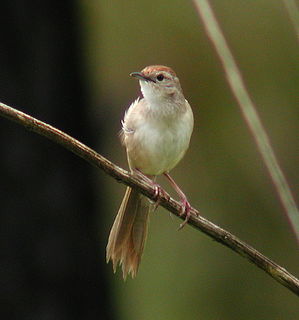
Cnemaspis is a genus of diurnal (day) geckos found in Africa and Asia. With over 100 species, it is one of the most diverse genera of geckos. Molecular phylogenies suggest that the three regional groupings may form distinct clades which are not each other's closest relatives.

The New Guinea long-eared bat, species Nyctophilus microtis, is a small flying mammal. It is found only in Papua New Guinea.

Nyctophilus corbeni, commonly known as the south-eastern long-eared bat or Corben's long-eared bat, is a species of bat found in Australia. It occurs in the woodlands of the Murray Darling Basin and adjacent areas.

The tawny grassbird is a songbird species of the grass- and bush-warbler family (Locustellidae). It was formerly placed in the "Old World warbler" assemblage.

The Timor python is a python species found in Southeast Asia. A dwarf form, no subspecies are currently recognized. Like all pythons, they are nonvenomous constrictors; unlike larger species such as the reticulated python, they are not considered dangerous to humans.
The Timor warty pig is a subspecies of Sus celebensis, or Celebes warty pig. Though described as a separate species, it is a feral form of the Celebes warty pig found in the Lesser Sunda Islands.

Nyctophilus is a genus of the vespertilionids or vesper bats. They are often termed big-eared bats or long-eared bats, as the length of their ears often greatly exceeds that of the head. This genus occurs in the New Guinean-Australian region.

Cnemaspis girii, also known as Giri's day gecko, is a species of geckos in the genus Cnemaspis described in 2014. The species, found in the forests of the Kaas plateau in Satara district, Maharashtra, India, was discovered by researchers from Bangalore's National Centre for Biological Sciences (NCBS) and Centre for Ecological Sciences (CES). The gecko lives under rocks and hollowed out trees near water bodies within its range.
Cnemaspis rajakarunai, also known as Rajakaruna's day gecko, is a species of diurnal geckos endemic to island of Sri Lanka, from Lowland Rainforest near Salgala. The species can be identified due to absence of precloacal pores. Male is known to ranges from 36–40 mm in length from snout to vent.
The western gecko is a species of gecko found in Guinea, Sierra Leone, and Ivory Coast.
Cnemaspis petrodroma, also known as the Nigeria crag gecko or Ondo forest gecko, is a species of gecko endemic to Nigeria.
Cnemaspis affinis, also known as Stoliczka's gecko or Pinang Island rock gecko, is a species of gecko endemic to Malaysia.

Cnemaspis argus, also known as the Argus rock gecko, Dring's gecko, or Lawit Mountain rock gecko, is a species of gecko endemic to western Malaysia.

Cnemaspis jacobsoni is a species of gecko, a lizard in the family Gekkonidae. The species is endemic to Indonesia.
The Mount Elgon forest gecko is a species of gecko endemic to Kenya and Uganda.
Cnemaspis australis, also known as the southern day gecko, is a species of gecko endemic to southern India.

The Mysore day gecko is a species of gecko endemic to southern India.

Nyctophilus major, referred to as a western long-eared bat, is a species found in forests and woodlands of Southwest Australia.









